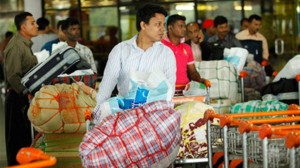Today, the Ministry of Foreign Affairs of the government of Bangladesh and the Swiss Agency for Development and Cooperation (SDC) are jointly hosting a two-day expert group meeting on Migration and the Post-2015 Sustainable Development Agenda. About 60 countries are participating in this meeting in Dhaka.
This is an extremely important global event for those who would like to see migration as a tool for sustainable development. Over the last fifteen years, the global development community, under the auspices of the United Nations, concentrated on reducing poverty through pursuing the Millennium Development Goals (MDGs). Some of the goals have been achieved and others have not. Nonetheless, migration played an important role in achieving those goals.
The Rio+20 Conference proposed a number of sustainable development goals in a document titled “The Future We Want.” The document committed to systematically consider population trends including migration. This year, in the 68th session of the UN Assembly, the global development agenda will be finalised under the broad heading of Sustainable Development Goals (SDGs). Inclusive intergovernmental processes and open-ended working groups have been working since February 2013 to recommend the goals. The expert group meeting that is taking place in Dhaka aims to propose inclusion of migration in the post 2015 sustainable development agenda.
Various civil society organisations in Bangladesh and their international partners that work on migration support this proposal. Following are some of the evidence that demonstrate that inclusion of migration into the post-2015 Agenda will help attain SDGs.
Across Asia, Africa, and Latin America, research is showing the development outcome of migration in origin and destination countries. This essay highlights the contribution of migration in countries of origin. Gainful employment and higher incomes are some of the benefits that individuals derive out of migration. Compared to non-migrant households, the size of the family income of migrant households are much larger. In South Africa, remittances constitute a significant one-third of total family income of rural households. In Mali, savings from remittances work as insurance during unexpected climatic events. During periods of drought, families in Ethiopia can avoid selling livestock and other assets by using their cash reserve from remittances.
Of course, remittances have differential benefits to different household members depending on their relationship with the household decision makers. It is mostly the male adults who have more leverage over the use of remittances. Nonetheless, migration of male members resulted in the economic and social empowerment of many left-behind wives. A cross-continental study of the World Bank (2010) found that left-behind families of migrants can ensure better quality education for their children compared to their non-migrant families. These families spend a high proportion of their monthly expenditure on education and health. In the long run, it contributed to human capital formation. The Living Standard Survey (2001) of Vietnam found that remittances are disproportionately directed towards those who are more than fifty years of age. Therefore it acts as social security of elderly members of the family.
Enough evidence has been gathered now to argue that remittances contribute to agricultural development. Remittances of the Filipino domestic workers acted as capital flow stimulating commercial agriculture. Agricultural growth of Kerala has been solely attributed to investment of short term contract migrant families. Migrant families contribute to the modernisation of agriculture by using water pump irrigation, seeds, fertilisers, pesticides, irrigation pumps, mechanised power tiller, tractor, etc.
The UNDP (2009) study of 71 developing countries found that a 10% increase in per capita official remittance would lead to a 3.5% decline in the number of people living in poverty. Remittances account for one-third to one-half of the overall reduction of the poverty rate in Nepal. In case of Bangladesh, the RMMRU-RPC (Research Programme Consortium) study (2014) of poverty headcount (calculated on the basis of $1.25 as the poverty line) found that 68% of the people belonging to non-migrant households lived below the poverty line whereas only 20% of international migrants and 39% of internal migrants belonged to that category.
Migrants’ food consumption pattern and investment in homestead and infrastructure creates multiplier effects on the local marketplace. Local markets respond to demands created by migrants and their families. This results in the introduction of new products, opening of more stores, and creation of employment. RMMRU-SDC study (2014) on the impact of migration on poverty and development shows that international migration facilitates seasonal internal migration, and spreads the benefit of migration to non-international migration-producing villages. More importantly, it results in stabilising unnecessary wage fluctuation in international migrant-producing areas.
The main emphasis of Rio+20 was that development should be environmentally sustainable. The RMMRU-SCMR (Sussex Centre for Migration Research) 2014 study based on 1500 migrant and non-migrant households found that on average, each family had to move 2.61 times due to different environmental stresses. 75% of all households, both migrant and non-migrant, experienced different types of climatic stresses. Nonetheless, those families who combined local level adaptation practices with livelihood migration of a few members of the household coped better with climatic stresses.
Moreover, local level adaptation programs sometimes put much stress on local resources, and in some situation trap climate change-affected people into situations of chronic and occasional poverty. In promoting climate-friendly development under SDG, voluntary migration is an important element to be integrated into the new development discourse.
On the basis of the above evidence, we strongly argue for incorporating migration into the SDG agenda. In several of the focus areas of the emerging SDG agenda such as eradication of poverty, health and population, education, employment and decent work for all, and promotion of equality, migration can be successfully integrated.
Source: Dhaka Tribune










